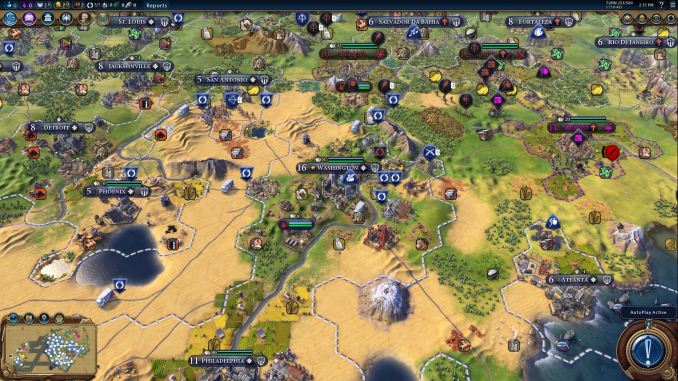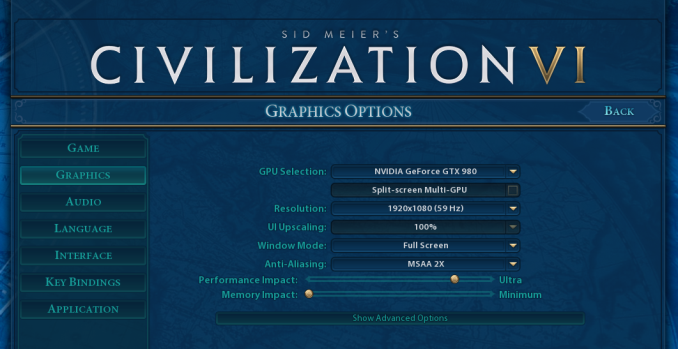Retesting AMD Ryzen Threadripper’s Game Mode: Halving Cores for More Performance
by Ian Cutress on August 17, 2017 12:01 PM ESTCivilization 6
First up in our CPU gaming tests is Civilization 6. Originally penned by Sid Meier and his team, the Civ series of turn-based strategy games are a cult classic, and many an excuse for an all-nighter trying to get Gandhi to declare war on you due to an integer overflow. Truth be told I never actually played the first version, but every edition from the second to the sixth, including the fourth as voiced by the late Leonard Nimoy, it a game that is easy to pick up, but hard to master.
Benchmarking Civilization has always been somewhat of an oxymoron – for a turn based strategy game, the frame rate is not necessarily the important thing here and even in the right mood, something as low as 5 frames per second can be enough. With Civilization 6 however, Firaxis went hardcore on visual fidelity, trying to pull you into the game. As a result, Civilization can taxing on graphics and CPUs as we crank up the details, especially in DirectX 12.
Perhaps a more poignant benchmark would be during the late game, when in the older versions of Civilization it could take 20 minutes to cycle around the AI players before the human regained control. The new version of Civilization has an integrated ‘AI Benchmark’, although it is not currently part of our benchmark portfolio yet, due to technical reasons which we are trying to solve. Instead, we run the graphics test, which provides an example of a mid-game setup at our settings.
At both 1920x1080 and 4K resolutions, we run the same settings. Civilization 6 has sliders for MSAA, Performance Impact and Memory Impact. The latter two refer to detail and texture size respectively, and are rated between 0 (lowest) to 5 (extreme). We run our Civ6 benchmark in position four for performance (ultra) and 0 on memory, with MSAA set to 2x.
For reviews where we include 8K and 16K benchmarks (Civ6 allows us to benchmark extreme resolutions on any monitor) on our GTX 1080, we run the 8K tests similar to the 4K tests, but the 16K tests are set to the lowest option for Performance.
All of our benchmark results can also be found in our benchmark engine, Bench.
We tested both of the 1950X and the 1920X at their default settings, as well as the 1950X in Game Mode as shown by 1950X-G.
MSI GTX 1080 Gaming 8G Performance
1080p



4K



8K



16K



ASUS GTX 1060 Strix 6G Performance

1080p



4K



Sapphire Nitro R9 Fury 4G Performance

1080p



4K



Sapphire Nitro RX 480 8G Performance

1080p



4K
















104 Comments
View All Comments
MrSpadge - Thursday, August 17, 2017 - link
It's definitely good that reviewers test the game mode and the others, so that we know what to expect from them. If they only tested creator mode the internets would be full of people shouting foul play to bash AMD.deathBOB - Thursday, August 17, 2017 - link
Ian - why not just enable NUMA and leave SMT on?Ian Cutress - Thursday, August 17, 2017 - link
The fourth corner of testing :)lelitu - Thursday, August 17, 2017 - link
Looking at setting up something for a home VM host, and linux development workstation makes NUMA with SMT the most useful set of benchmarks for my usecase.I'm particularly interested in TR, because it's brought the price of entry low enough that I can actually consider building such a system.
Ratman6161 - Friday, August 18, 2017 - link
ThreadRipper is big bucks for your purposes if I'm reading this correctly. For a home lab sort of environment a lot of cores helps as does a lot of RAM, but you don't necessarily need a boatload of CPU power. For example, in my home ESXi system I've got an FX8350 which VMWare sees as an 8 Core CPU. I've also given it 32 GB of DDR3 RAM (purchased when that was cheap). The 990FX motherboards work great for this since they have plenty of PCIe lanes available. In my case, those are used for an ancient ATI video card I happened to have in a drawer, an LSI x8 RAID card and an x4 Intel dual port gigabit NIC. The RAID card has 4 1 TB desktop drives hooked up to it in a RAID 5.All of the above can be had pretty cheap these days. I'm thinking of upgrading my storage to 4x2 TB SAS drives - available for $35 each on Amazon...brand new (but old models). The system is running 6 to 7 VM's (Windows Servers mostly) at any given time. But with only two users, I don't run into many cases where more than two VM's are actually doing anything at the same time. Example: Web server and SQL Server serving up a web app.
For this environment, having a storage setup where the VM's are not contending for the disks and also having plenty of RAM seems to make a lot more difference than the CPU.
Of course if you have the bucks and just want to, ThreadRipper would be terrific for this - just way to expensive and overkill for me.
lelitu - Monday, August 21, 2017 - link
That depends a lot on what you want the VMs for. Unfortunately for the sort of performance testing and development I do a VM toaster isn't actually good enough. Each VM needs at least 4 uncontended cores, and 10GB uncontended RAM. Two VMs is the absolute minimum, 3 would be better.That's not going to fit into anything less than a ryzen 7 minimum, and a Threadripper, *if* it performs as I expect in SMT + NUMA mode would be almost perfect. Unfortunately, you're right, it's a *lot* of coin to drop on something I don't know will actually do what I need well enough.
Thus, I wish there were SMT+NUMA workstation and VM benchmarks here.
JasonMZW20 - Thursday, August 17, 2017 - link
Seems like Game Mode should have bumped up the base clocks to 1800X levels, especially for Nvidia cards using a software scheduler that seems to scale with CPU frequency. AMD's hardware scheduler is apparent in overall FPS stability and being mostly CPU agnostic.Matching base clocks with 1800X or even 1900X (3.8GHz) might be better on TR for gaming in Game Mode.
lordken - Friday, August 18, 2017 - link
Also for some weird reason that 1800X is much faster with higher fps in civilization and tomb rider?peevee - Thursday, August 17, 2017 - link
"because the 1920X has fewer cores per CCX, it actually falls behind the 1950X in Game Mode and the 1800X despite having more cores. "Sorry, but when 12 cores with twice memory bandwidth are compiling slower than 8, you are doing something wrong. Yes, Anandtech, you. I'd seriously investigate. For example, the maximum number of threads were set at 24 or something.
Ian Cutress - Thursday, August 17, 2017 - link
When you have a bank of cores that communicate with each other, and replace it with more cores but uneven communication latencies, it is a difference and it can affect code paths.